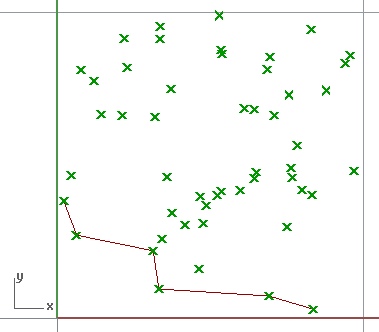A method for returning a collection of Pareto-optimal data. Pareto analysis is used in multi-objective optimisation to search for potential non-dominated solutions, i.e. solutions for which there are no solutions that perform better in every objective being assessed.
Input a collection of data. This data is accepted as Grasshopper’s DataTree format. The ‘tree’ contains a collection of branches. Each branch contains a list. Each list corresponds to the list of objective results corresponding to a single node.
The method sorts the input data into two DataTrees: Pareto-optimal branches and non-Pareto-optimal branches.
The algorithm is simple and unsophisticated, running in O(n2). It is fine for smaller data sets, though you may wish to investigate more sophisticated algorithms for larger datasets.
C# code to find the Pareto front
private void RunScript(DataTree<double> data, ref object opt, ref object nonopt) { DataTree<double> optimal = new DataTree<double>(); DataTree<double> nonoptimal = new DataTree<double>(); //data should be a tree, where each branch is equivalent to one data point, and the length of the list is equal to the number of parameters. for(int n = 0; n < data.BranchCount; n++) //for each node { //check it against every other node //we need to find one node where every parameter is superior. if not, we have pareto optimality bool superiornodefound = false; for (int i = 0; i < data.BranchCount; i++) //check node i { bool issuperior = true; for(int p = 0; p < data.Branch(0).Count; p++) { if(data.Branch(i)[p] > data.Branch(n)[p]) { issuperior = false; break; } } if(issuperior && i != n) superiornodefound = true; } if(superiornodefound) nonoptimal.AddRange(data.Branch(n), new GH_Path(nonoptimal.BranchCount)); else optimal.AddRange(data.Branch(n), new GH_Path(optimal.BranchCount)); } //return outputs opt = optimal; nonopt = nonoptimal; //grasshopper-related UI double optimalratio = Math.Round(100.0 * optimal.BranchCount / data.BranchCount, 1); Component.Message = optimalratio.ToString() + "% optimal"; Component.Description = optimalratio.ToString() + "% of solutions are Pareto optimal."; }

